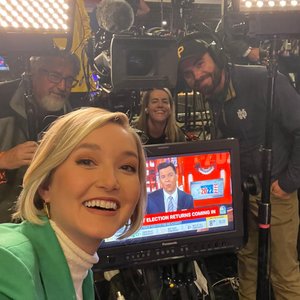NBCU Academy Presents “Behind the Story”
Go Behind the Story with Dasha Burns, NBC News correspondent and NBC News producer Abby Brooks as they cover the 2022 midterm elections in Pennsylvania.

Burns: How do you prepare for election night?
Paul Rigney: How do I prepare? Mountain Dew. A lot of caffeine. It’s going to be a long day. I make sure all my batteries are charged, make sure all my gear is organized, and figure out what we’re going to do for the day and get organized accordingly.
Burns: Right now, we’re on a riser with a bunch of other media. When you get here, how do you make sure everything looks and sounds good? Walk me through the setup.
Rigney: First you do a site survey, which is when you come and check out the space. If it’s too small, there’s stuff I won’t bring in. In this case, I have my tripod, my camera and two lights. And I have a monitor that will give you a picture of what we’ve got on our broadcast.
Burns: Thom, tonight I’m using a stick microphone. Can you explain why we’re using this kind of microphone?
Thom Shafer: That’s a cardioid pattern stick microphone that has a really high signal-to-noise ratio. It ignores a lot more sound in the background, like music, people screaming and a lot of noise.

Burns: This thing I put in my ear is called an IFB. Can you explain what an IFB is and what you do with it?
Shafer: The IFB (interruptible foldback) is the program audio, it’s called a mix minus. It’s a mix of the program show from the studio in New York minus your sound. Because if you hear yourself, there’ll be a delay, and it’s really annoying to hear one and a half-second delay of your own voice coming back at you.
Burns: From this I can hear what’s on TV, and I can also hear people in the control room back at 30 Rock saying, “Hey, Dasha, you’re on in two minutes” or “Dasha, stop talking.”
Shafer: Yes, the producer or director can interrupt with directions for you.



